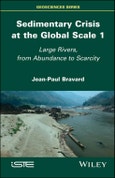Sedimentary Crisis at the Global Scale 1 examines how river basins have been affected by the sedimentary crises of various historical epochs. By studying global balances, it provides insights into the profound disruption of the solid transport of fluvial bodies. The book also explores studies of various rivers, from the Amazon, which remains relatively unaffected, to dying rivers such as the Colorado and the Nile.
Table of Contents
Foreword ix
Preface xi
Introduction xv
Chapter 1 The Torrential Crisis in the European Mountains (14th-19th Centuries) 1
1.1 Introductory generalities on global fluvial systems 1
1.2 Manifestations of the LIA crisis in the river valleys of Western Europe 5
1.2.1 Mountain crises 5
1.2.2 River crises and metamorphoses of the Drac and the Isère in Grenoble 7
1.2.3 Flooded piedmont plains in Switzerland 11
1.2.4 Sedimentation and large works in Italy 12
1.3 The difficult mastery of the Rhine delta in the modern era 17
1.3.1 Flow distribution between river branches: an age-old battle against the elements of nature 17
1.3.2 Returns on destabilization 19
1.4 Observations on the torrentiality of the Southern Alps in the late 18th and 19th Centuries 20
1.4.1 A highly degraded state of affairs in the late 18th Century 20
1.4.2 Prefect Pierre-Henri Dugied’s project (1819) 23
1.4.3 Alexandre Surell, author of the French policy for restoring mountain territories 23
1.4.4 The restoration of mountain land (RTM) 28
1.4.5 The Southern Prealps (Drôme): what kind of balance in torrential milieus? 31
1.5 The sediment conveyor belt, from torrents to outlets 32
1.5.1 The forester Georges Fabre, from the Aigoual to the Gironde 32
1.5.2 The Rhône river trough 33
1.5.3 The redistribution of alluvia in the upper delta of the Rhône 35
1.5.4 Solid contributions to the Rhône outlet and progression of the Camargue delta 35
Chapter 2 Continuity in European Hydraulic Science (16th-18th Centuries) 39
2.1 From hydraulic architecture to the fluvial system: transalpine preeminence 41
2.1.1 At the roots of European science 42
2.1.2 A great Italian scholar, Paolo Frisi 44
2.2 The first naturalist approaches to the water cycle in the Seine basin 50
2.2.1 Pierre Perrault 51
2.2.2 Edme Mariotte 52
2.2.3 French hydraulic science in the 18th Century 53
2.2.4 Emergence of the natural state of rivers in the mid-18th Century 59
2.2.5 Jean-Antoine Fabre, the great naturalist engineer of Southern Alpine torrents 62
2.3 Conclusion 67
Chapter 3 Exploited Nature and the River’s Responses to the Globe’s Surface 69
3.1 Mistreated soil and accelerated erosion 71
3.1.1 The Huang-He (Yellow River) basin: accelerated erosion in a highly fragile milieu 71
3.1.2 Soil erosion in North America 77
3.1.3 Accelerated erosion on the Great Russian Plains, from Belarus to the Urals 83
3.1.4 New Zealand, “destruction on the pretext of development” 86
3.2 Mineral predation and river bursts 91
3.2.1 Lead and zinc in the Pennines: mines threatening dairy livestock 92
3.2.2 The “debris” from the gold-bearing alluvia of the Sierra Nevada (California) 93
3.2.3 The coal mines of the Loess Plateau, the Huang-He watershed 100
3.2.4 Mountaintop mining in the Appalachians at the risk of downstream reaches 101
3.3 Conclusion 104
Chapter 4 From Hills to the Ocean: Production, Transfer and Trapping 107
4.1 Global continental contributions to oceans 107
4.1.1 Continental denudation and sediment flux to river mouths 108
4.1.2 Natural sediment interception on the way to oceans 112
4.1.3 Disturbances in “geological” fluxes during the Anthropocene 117
4.2 Selected case studies on the Earth’s surface 121
4.2.1 The Yangzi basin 121
4.2.2 The sediment load of rivers in mountain regions subject to tropical cyclones 121
4.2.3 The effects of the recent protection of degraded continental milieus 122
4.2.4 Mining and the increase in river loads 125
4.3 Irreversible flux disturbances 126
4.3.1 The major role of artificial reservoirs 126
4.3.2 Hydrological and sedimentary effects 127
4.3.3 Trapping and effects on sediment transfer 129
4.3.4 River diversion, loss of transport capacity and trapping 131
4.3.5 Predation of river resources: sand and gravel 135
Chapter 5 The Recent Hydrosedimentary History of Some of the Globe’s Largest Rivers 145
5.1 A river in its natural state, the Amazon 146
5.1.1 The river in its basin 146
5.1.2 River function 147
5.1.3 The threat of dams 149
5.2 Adjusted rivers in China and Southeast Asia 150
5.2.1 The Huang-He downstream of the Loess Plateau: contemporary generalities 150
5.2.2 The Yangtze and the Three Gorges Dam 155
5.2.3 The Mekong 160
5.3 The Mississippi, an altered river in a new country 166
5.3.1 Basin and hydrology 166
5.3.2 Geology of the Mississippi basin 167
5.3.3 Aspects of the river 168
5.3.4 Modifications to the sedimentary budget 170
5.4 Overexploited rivers in regions with a water deficit 176
5.4.1 The God River and the Aswan Dams 176
5.4.2 The Colorado River 182
Conclusion 189
Glossary 193
Bibliography 199
Index of Common Terms219
Index of Places 223
Index of Names 229








